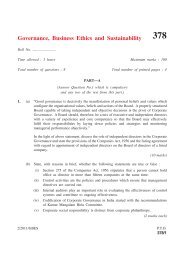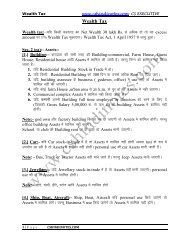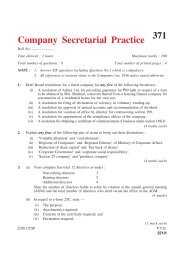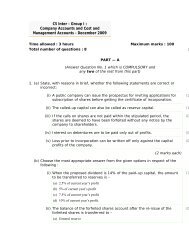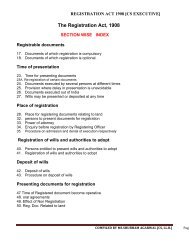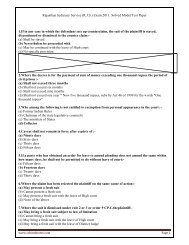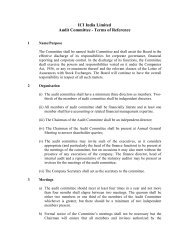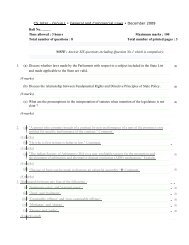SOLVED PAPER GCL JUNE 2011 - CS NOTES
SOLVED PAPER GCL JUNE 2011 - CS NOTES
SOLVED PAPER GCL JUNE 2011 - CS NOTES
You also want an ePaper? Increase the reach of your titles
YUMPU automatically turns print PDFs into web optimized ePapers that Google loves.
<strong>SOLVED</strong> <strong>PAPER</strong><br />
<strong>GCL</strong> <strong>JUNE</strong> <strong>2011</strong><br />
<strong>CS</strong> Executive Programme Module ‐ I Paper ‐1 General and<br />
Commercial Laws<br />
Note : Answer SIX questions including Question No. 1 which is compulsory.<br />
<strong>2011</strong> ‐ June [1] {C} (a) Explain powers of the Parliament to enact laws on subjects enumerated in<br />
the State List. (8 marks)<br />
Ans. The Parliament can extend the legislative powers given to it by the Constitution to formulate<br />
laws under special situations to include certain subjects of the State List. Some of the conditions<br />
under which the Parliament may extend its powers include the situations explained below‐<br />
In the National Interest (<br />
Proclamation of Emergency Under Article 249) (Article 250) in any<br />
state by the President.<br />
If two states agree that the Parliament can legally make laws with respect to the two states, then the<br />
Parliament can make laws relating to any state or states (Under Article 252)<br />
For the implementation of treaties in the international interest of the country (Under Article 253).<br />
Failure of Constitutional Machinery in a State as a result of the inefficiency of a State Legislature, as<br />
declared by a proclamation issued by the President (Under Article 356 (1) (b) )<br />
Normally both the Union Government and the State Governments operate within the limitations of<br />
the powers given to them by the Constitution. They enjoy equal powers to make laws relating to the<br />
Concurrent list items, which are of general importance such as succession, transfer of property,<br />
preventive detention, education, etc. If there arises a conflict between a law passed by the Union<br />
and that passed by one or more State Legislatures, precedence would be given to the law made by<br />
the Union Parliament. However, problem arises when either the Union or a State illegally encroaches<br />
upon the powers of the other legislature, or they may arise because the two laws do not coordinate.<br />
Only where the legislation is on a matter in the Concurrent List, it becomes important to apply the<br />
test of repugnancy and judge which act will apply. Normally the Union law is given precedence,<br />
unless the State has reserved a law for the approval of the President, in which case it will supersede<br />
the law made by the Union. However, the Union can at all times cause an alteration or amendment<br />
in the law.<br />
<strong>2011</strong> ‐ June [1] {C} (b) Is it correct to say that Directive Principles of State Policy have to conform<br />
to and run as subsidiary to Fundamental Rights Discuss. (6 marks)<br />
Ans. The Supreme Court in the case of State of Madras v. Champakam Dorairajan (1951) SCR 525<br />
has stated that, “The directive principles have to conform to and run subsidiary to the chapter on<br />
fundamental rights.” Later, in the case referred to above, the majority opinions reflected the view<br />
that what is fundamental in the governance of the country cannot be less significant than what is<br />
significant in the life of the individual. Another judge constituting the majority in that case said: “In<br />
building up a just social order it is sometimes imperative that the fundamental rights should be<br />
subordinated to directive principles.” This view says that the fundamental rights and DPSP are<br />
complementary, “neither part being superior to the other.”<br />
The DPSP are seen as aids to interpret the Constitution, and more specifically to provide the basis,<br />
scope and extent of the content of a fundamental right.<br />
<strong>2011</strong> ‐ June [1] {C} (c) Write in brief the importance of the writ of habeas corpus.<br />
Ans. The writ of Habeas Corpus – It is passed to ensure that a person who is confined without a legal
cause being given gets justice. This writ orders the authority confining the person to give proper<br />
reasons for doing so. Articles 32 and 226 give the right to approach the Supreme Court and the High<br />
Courts for obtaining this writ. This writ is issued when a case outlining the need for such a writ is<br />
made. It ensures that no man is detained without the proper procedure being followed and without<br />
proper cause, and it keeps the authorities from arbitrary legal action. The person detained or his<br />
legal representative can move the court for this writ. This writ demands the restraining authority to<br />
present the detained person before the court with the proof that led to his arrest or detention. This<br />
allows the court to judge whether his detention was justified to begin with.<br />
<strong>2011</strong> ‐ June [2] Write notes on any four of the following :<br />
(i) Penalties which can be imposed on public information officer under section 20 of the Right to<br />
Information Act, 2005<br />
(ii) Temporary and perpetual injunction<br />
(iii) Malicious prosecution<br />
(iv) Res gestae<br />
(v) Primary and secondary evidence. (4 marks each)<br />
Ans. (i) Penalties which can be imposed on public information officer under section 20 of the Right to<br />
Information Act, 2005<br />
Section 20 (1) of the RTI Act states, “Where the Central Information Commission or the State<br />
Information Commission, as the case may be, at the time of deciding any complaint or appeal is of<br />
the opinion that the Central Public Information Officer or the State Public Information Officer, as the<br />
case may be, has, without any reasonable cause, refused to receive an application for information or<br />
has not furnished information within the time specified under sub‐section (1) of section 7 or<br />
malafidely denied the request for information or knowingly given incorrect, incomplete or<br />
misleading information or destroyed information which was the subject of the request or obstructed in<br />
any manner in furnishing the information, it shall impose a penalty of two hundred and fifty<br />
rupees each day till application is received or information is furnished, so however, the total amount<br />
of such penalty shall not exceed twenty five thousand rupees. However, the Central Public<br />
Information Officer or the State Public Information Officer, as the case may be, shall be given a<br />
reasonable opportunity of being heard before any penalty is imposed on him.<br />
Section 20 reveals that there are three circumstances where the Commission must<br />
impose penalty:<br />
1) Refusal to receive an application for information.<br />
2) Not furnishing information within the time specified under sub‐section (1) of section 7 – 30<br />
days.<br />
3) Malafidely denying the request for information or knowingly giving incorrect, incomplete or<br />
misleading information or destroying information which was the subject of the request<br />
4) Obstructing in any manner in furnishing the information.<br />
All the above are prefaced by the condition, ‘ without reasonable cause’<br />
(as per Decision No. CIC/SG/A/<strong>2011</strong>/000217/11995Penalty Appeal No. CIC/SG/A/<strong>2011</strong>/000217 of<br />
the CENTRAL INFORMATION COMMISSION)<br />
Ans. (ii) Temporary and perpetual<br />
I njunction<br />
‘Temporary injunctions’ or ‘interlocutory injunctions’, according to Order XXXIX of the Code of Civil<br />
Procedure, 1908, means an order passed by a court to restrain someone from doing something that<br />
would result in alienation of property, or its destruction, or when the plaintiff is in danger of being<br />
dispossessed altogether. The plaintiff needs to establish to the satisfaction of the court that the<br />
losses suffered by him would be irreversible, and of such a nature as cannot be compensated, if the<br />
injunction is not granted. Such an injunction is for a short duration of time, normally for the time<br />
taken by the court to reach a final decision. It is issued after the suit has been filed and when it<br />
remains pending. A prima facie case and balance of convenience in the plaintiff’s favor are essential<br />
to get a temporary injunction issued.
A ‘perpetual injunction’, often a ‘permanent injunction’, on the other hand, is a relief available to the<br />
plaintiff only at the conclusion of the trial. This type of injunction would be granted when the<br />
conditions that necessitated the injunction in the first place continue and are proved to be of a<br />
permanent nature. It is ordered using the final judgment.<br />
(iii) Malicious prosecution<br />
An action for malicious prosecution is the remedy for baseless and malicious litigation. It is not<br />
limited to criminal prosecutions but may be brought in response to any baseless and malicious<br />
litigation or prosecution, whether criminal or civil. The criminal defendant or civil respondent in a<br />
baseless and malicious case may later file this claim in civil court against the parties who took an<br />
active role in initiating or encouraging the original case. The defendant in the initial case becomes<br />
the plaintiff in the malicious prosecution suit, and the plaintiff or prosecutor in the original case<br />
becomes the defendant. In most states the claim must be filed within a year after the end of the<br />
original case.<br />
A claim of malicious prosecution is a tort action. A tort action is filed in civil court to recover money<br />
damages for certain harm suffered. The plaintiff in a malicious prosecution suit seeks to win money<br />
from the respondent as recompense for the various costs associated with having to defend against<br />
the baseless and vexatious case.<br />
To win a suit for malicious prosecution, the plaintiff must prove four elements: (1) that the original<br />
case was terminated in favor of the plaintiff, (2) that the defendant played an active role in the<br />
original case, (3) that the defendant did not have probable cause or reasonable grounds to support<br />
the original case, and (4) that the defendant initiated or continued the initial case with an improper<br />
purpose.<br />
(iv) Res gestae<br />
Section 6 of the Indian Evidence Act, 1872 opines the inclusion of res gestae in a case as relevant<br />
facts. They can be defined as those facts that were although incidental to the main fact but were<br />
explanatory of it, and hence to be included as relevant facts. They have to form part of the same<br />
transaction in order to be included within this definition.<br />
Secondhand statements considered trustworthy for the purpose of admission as evidence in a<br />
lawsuit when repeated by a witness because they were made spontaneously and concurrently with<br />
an event.<br />
Res gestae describes a common‐law doctrine governing testimony. Under the Hearsay rule, a court<br />
normally refuses to admit as evidence statements that a witness. Traditionally, two reasons have<br />
made hearsay inadmissible: unfairness and possible inaccuracy. Allowing a witness to repeat hearsay<br />
does not provide the accused with an opportunity to question the speaker of the original statement,<br />
and the witness may have misunderstood or misinterpreted the statement. Thus, in a trial, counsel<br />
can object to a witness's testimony as hearsay.<br />
Res gestae is based on the belief that because certain statements are made naturally,<br />
spontaneously, and without deliberation during the course of an event, they carry a high degree of<br />
credibility and leave little room for misunderstanding or misinterpretation. The doctrine held that<br />
such statements are more trustworthy than other secondhand statements and therefore should be<br />
admissible as evidence.<br />
(v) Primary and secondary evidence<br />
‘Primary evidence’ as per the Indian Evidence Act, 1872 means the very document itself, not a copy<br />
of it. The provision of primary evidence is based on the ‘Best Evidence’ principle, i.e. if there is better<br />
evidence available, then that must be provided. If the person capable of providing superior evidence<br />
supplies an inferior one, it creates an unfavorable stance against him. (Section 62)<br />
‘Secondary evidence’ means certified or compared copies of, or counterparts of, or oral accounts of<br />
documents. (Section 63)<br />
According to Section 65 of the Act, where primary evidence can be provided, secondary evidence<br />
should not be used. It should only be given where the original document is not available because it<br />
has been lost or destroyed, or it is otherwise unavailable because it cannot easily be moved because<br />
of bulk, or because it is under the control of some public authority’s control.<br />
<strong>2011</strong> ‐ June [3] (a) Mention the circumstances under which refund of stamp duty or penalty may be
made by revenue authorities. (4 marks)<br />
Ans. As per the provisions of sections 49, 50, 52, 53 and 54, Stamp Duty can be refunded under the<br />
following circumstances:<br />
1. Spoiled Stamps;<br />
2. Misused Stamps;<br />
3. Stamps used in excess of the value required; and<br />
4. Stamps not required for use.<br />
The stamps purchased and not used for intended purpose are entitled for refund after deduction of<br />
certain charges, if lodged for refund within six months from the date of purchase<br />
<strong>2011</strong> ‐ June [3] (b) State the documents whose registration is optional under the Registration Act,<br />
1908. (4 marks)<br />
Ans. Section 18 of the Registration Act, 1908 provides for those documents whose registration is<br />
optional. These are as under –<br />
Instruments that create, extinguish or alter any right or interest in immovable property exceeding<br />
rupees one hundred in value.<br />
Instruments that recognize the receipt of any recompense for the above.<br />
Instruments that create, extinguish or alter any right or interest in movable property.<br />
Leases for which registration is exempted and the period of which is less than a year.<br />
Wills<br />
Instruments create, extinguish or alter any right or interest in immovable property for less than<br />
rupees hundred.<br />
<strong>2011</strong> ‐ June [3] (c) Discuss the rule of harmonious construction in the interpretation of statutes. (8<br />
marks)<br />
Ans. Rule of Harmonious Construction ‐ Where two provisions of the same enactment cannot be<br />
reconciled with each other they should be so interpreted that, if possible, effect may be given to<br />
both. This is the rule of Harmonious Construction. It helps in maintaining a link between the parts of a<br />
statute or between parts within a particular section when there is any discrepancy between them. By<br />
doing so, it ensures that no part is rendered redundant. The meaning is so construed that both the<br />
parts play a role in it.<br />
This rule of interpretation means that any section or part of a statute should be read with reference<br />
to the entire act, i.e. the meaning should be construed in entirety, not singularly. If while<br />
constructing the meaning of a section, it conflicts with the meaning given in another, in all<br />
probability there is an error in interpretation. Hence if two sections in the same statute seem to give<br />
different meanings or lead to opposite directions, the interpretation should be such as can<br />
accommodate both meanings.<br />
When two statutes are complementary to each other. One statute cannot be allowed to overrule the<br />
other. Instead one statute should be interpreted in such a way to compromise with the other<br />
statute. This is called Harmonious construction of Statutes.<br />
<strong>2011</strong> ‐ June [4] (a) The law of limitation bars the remedy in a court of law when the period of<br />
limitation has expired. However, there are certain exclusions in the computation of the period of<br />
limitation. Explain. (4 marks)<br />
Ans. Extension of limitation period and the Doctrine of Sufficient<br />
Cause<br />
Extension of limitation period is covered under Section 5 of the Limitation Act, 1963, which<br />
covers the Doctrine of Sufficient Cause. It provides for the period of limitation being extended in<br />
case the plaintiff was hindered by a cause serious enough to have prevented him from initiating<br />
proceedings. Calculation of Limitation Period<br />
Sections 12 to 19 and Section 24, which are contained in Part III of the Limitation Act, 1963, titled<br />
“Computation of Period of Limitation”, provide the details for this. They are as under –
Section 12 – It says that the time required for filing a suit, appeal or application, either against a<br />
decree or order or otherwise, is exclusive of the day from which the limitation period is calculated.<br />
Moreover, the time needed for obtaining a copy of the order being appealed against is also to be<br />
excluded.<br />
Section 13 – The time during which the suit for being adjudged a pauper is applied for but not<br />
decided.<br />
Section 14 – The period that was taken by a court that had no jurisdiction on a matter that was<br />
under question, and the plaintiff had applied to that court in the mistaken belief that it had power to<br />
entertain that suit.<br />
Section 15 – Under this Section certain other situation in which there would be an extension of time<br />
in calculating the period of limitation are given. For example, in case of the defendant being out of<br />
India and arriving after the suit has been instituted, only the time when he is in India shall be<br />
included.<br />
Section 16 – In case the plaintiff’s right to appeal is hindered by his death, the period shall be<br />
calculated from the time when there is a representative appointed for the plaintiff.<br />
Section 17 – In case the suit or application has been initiated on the basis of some fraud, the period<br />
of limitation would be counted from the date when the fraud is discovered.<br />
Section 18 – This section states that in case of an acknowledgement regarding any property or right<br />
in relation to which any claim has been made against him, a fresh period of limitation will commence<br />
from the date of such acknowledgement.<br />
Section 19 – This records the cases of a debt or interest on legacy, on account of which if interest is<br />
paid, it results in a fresh period of limitation commencing from the date of such payment. Section<br />
24 – all periods shall be calculated in accordance with the standard Gregorian calendar.<br />
June [4] (b) Distinguish between the following :<br />
'Congnizable offence' and 'non‐congnizable offence'.<br />
Ans. A ‘cognizable offence’ means an offence for which no bail is available. It is an offence for which<br />
anyone can be arrested without a warrant. This is as per the Code of Criminal Procedure, 1973,<br />
Section 2. These are outlined in the First Schedule to the Code. An example of a cognizable offence<br />
would be murder. These are generally non‐bailable offences.<br />
A ‘non‐cognizable offence’, on the other hand, is an offence for which the perpetrator cannot be<br />
arrested without a warrant. These are bailable as they are not of as serious a nature as the<br />
cognizable offences, an example of which is petty theft.<br />
If there are multiple offences, and even one is cognizable, all of them would be handled as<br />
cognizable offences.<br />
'Hacking' and 'passing off'.<br />
Ans. ‘Hacking’ means done by unlawful access of a computer resource or system owned or<br />
controlled by another and altering, deleting or adding unauthorized information. Such a change<br />
might result in the lessening or loss of the value of the original information contained in the system.<br />
The punishment for this offence as per the Information Technology Act, 2000 is three years of<br />
imprisonment and/or fine upto rupees two lakhs. (Section 66)<br />
Hacking definitely affects the financial returns of a company, since the hacker takes a large slice of<br />
the profits. It might also cause loss of reputation to the company whose Id is hacked, or it may even<br />
cause company secrets to be brought out into the open if the confidential information of the<br />
company is accessed.<br />
'Computer network' and 'computer system'. (4 marks each)<br />
Ans. ‘Computer network’ and ‘Computer system’ – According to Section 2(1)(l) of the Information<br />
Technology Act, 2000, “Computer System" implies a gadget or a collection of gadgets that are<br />
programmable and support external files and data, instructions etc., and are capable of responding to<br />
instructions by giving the output as data, images or in any other desired form or format. It
performs all the functions from accepting data and information, to storing it, to presenting it in a<br />
different mode of output.<br />
Section 2(1)(j) defines ‘Computer network’ as the connection or linkage between two or more<br />
computer systems with the help of any mode – connecting wire or optical media, satellite or remote<br />
terminals.<br />
<strong>2011</strong> ‐ June [5] (a) Re‐write the following sentences after filling‐in the blank spaces with appropriate<br />
word(s)/figure(s) :<br />
(i) The publication of defamatory statement through written words is known as libel . (1 mark)<br />
(ii) A pending suit, action, petition or the like is known as lis pendens. (1 mark)<br />
(iii) The doctrine which underlines the general principle that no one shall be vexed twice for the<br />
same cause is known as res judicata. (1 mark)<br />
(iv) A statement given by a judge on the grounds of decree or order is known as judgement . (1<br />
mark)<br />
(v) Actionable claims are claims to unsecured debts. (1 mark)<br />
<strong>2011</strong> ‐ June [5] (b) Write the most appropriate answer from the given options in respect<br />
of the following :<br />
(i) The Constitution of India was enacted on ‐ (a) 26th November, 1949<br />
(b) 26th January, 1950 (c) 28th January, 1950<br />
(d) None of the above. (1 mark)<br />
Ans. (b) 26th January, 1950<br />
(ii) The Preamble of the Constitution ‐<br />
(a) Is a part of the Constitution<br />
(b) Can be used for interpreting the Constitution<br />
(c) Both (a) and (b)<br />
(d) None of the above. (1 mark)<br />
Ans. (c) Both (a) and (b)<br />
(iii) The relief of cancellation of instrument is founded upon the principle of ‐<br />
(a) Preventive justice (b) Protective justice (c) Proper justice<br />
(d) None of the above. (1 mark)<br />
Ans. (b) Protective justice<br />
(iv) As per the Transfer of Property Act, 1882, a person is an ostensible owner of an immovable<br />
property where he becomes interested therein by ‐ (a) Express consent<br />
(b) Implied consent<br />
(c) Either (a) or (b)<br />
(d) Both (a) and (b). (1 mark)<br />
Ans. (c) Either (a) or (b)<br />
(v) Second appeal to the Central Information Commission or the State Information<br />
Commission, as the case be, may be filed within ‐ (a) 30 days<br />
(b) 60 days<br />
(c) 90 days<br />
(d) 120 days. (1 mark)<br />
of the date on which the decision was given by the First Appellate Authority.<br />
Ans. (c) 90 days<br />
(vi) The right of review has been conferred by the Code of Civil Procedure, 1908. It provides that any<br />
person considering himself aggrieved by a decree or order may apply for a review of the judgement to<br />
the ‐<br />
(a) Appellate Court
(b) High Court<br />
(c) District Court<br />
(d) Court which passed the decree or order. (1 mark)<br />
Ans. (d) Court which passed the decree or order.<br />
<strong>2011</strong> ‐ June [5] (c) Define res judicata and state the conditions of its application.<br />
Ans. ‘The Doctrine of Constructive Res Judicata’ has been provided in Section 11 of the Code of Civil<br />
Procedure, 1908. It prevents further suits being filed for a matter that is at the core of a former<br />
suit. The reasons are as below –<br />
The same party should not be troubled with the same matter again and again.<br />
There should be a limit to the number of cases filed in a court, i.e. vexatious cases should not be<br />
entertained.<br />
The same matter should not be used for wasting valuable court time repeatedly.<br />
All reliefs claimed but not given will be deemed to be refused.<br />
The court which tried the previous suit should be competent to try the latter suit.<br />
The basic requirement for applying this doctrine is that the matter that is at the core of the former<br />
suit should also be the main essence of the latter suit(s). (5 marks)<br />
<strong>2011</strong> ‐ June [6] State, with reasons in brief, whether the following statements are true or false :<br />
(i) A contract which is dependent upon the personal qualifications can be specifically enforced.<br />
Ans. False. As per Section 14 of the Specific Relief Act, contracts of personal volition or qualification<br />
cannot be specifically enforced, as the quality of work performance cannot be ensured, nor can the<br />
continuity be ensured.<br />
(ii) 'Arbitral tribunal' means a sole arbitrator or a panel of arbitrators.<br />
Ans. True. As per Section 2 (1) (d) and Section 10 of the Arbitration and Conciliation Act, 1996<br />
(iii) A mere right to sue can be transferred.<br />
Ans. False, As per Section 6 (e) of the Transfer of Property Act.<br />
(iv) A complaint in a criminal case is what a plaint is in a civil<br />
Case.<br />
Ans. True, A complaint in CrPC means a complaint made to a magistrate. It is defined in Section 2(d)<br />
of CrPC. As per the section it means any allegation made orally or in writing to a Magistrate, with a<br />
view to his taking action under this Code, that some person, whether known or unknown, has<br />
committed an offence, but does not include a police report.<br />
(v) In a declaratory decree, the right of any person to any property or his legal character is<br />
ascertained.<br />
Ans. True. A declaratory judgment is a judgment of a court which determines the rights of parties<br />
without ordering anything be done or awarding damages.<br />
(vi) A writ of certiorari is issued to prevent a lower court from usurping jurisdiction which is not<br />
legally vested in it.<br />
Ans. False. A writ of certiorari is issued to question what right the person acquiring any powers have<br />
to acquire them. Where they exceed their legal authority, they can be questioned using this writ.<br />
(vii) All documents produced for the inspection of the court are known as documentary evidence.<br />
Ans. True. As per Section 3 of the Indian Evidence Act.<br />
(viii) An instrument not 'duly stamped' can be accepted in evidence by an arbitral tribunal.<br />
Ans. True. An instrument not 'duly stamped' can be accepted in evidence by an arbitral tribunal, but<br />
only after having paid the requisite penalty.<br />
(2 marks each)
<strong>2011</strong> ‐ June [7] (a) Alok was running a school at a certain place. Bimal started another school near<br />
the school of Alok. As a result of this, most of the students of Alok's school left his school and joined<br />
Bimal's school. Due to competition, Alok had to reduce the fees by ` 40 per student per quarter<br />
thereby suffering huge monetary loss. Alok instituted a suit against Bimal in the court for claiming<br />
compensation. Is the suit instituted by Alok maintainable (6 marks)<br />
Ans. In the law of torts there are two types of doctrines under the law of torts – Injuria sine<br />
damnum, and damnum sine injuria.<br />
There are many acts which though harmful are not wrongful and give no right of action to him who<br />
suffers from their effects. Damage so done and suffered is called Damnum Sine Injuria or damage<br />
without injury. Damage without breach of a legal right will not constitute a tort. Such examples<br />
would constitute injury but not damage, as per the rules of torts. They are instances of damage<br />
suffered from justifiable acts. An act or omission committed with lawful justification or excuse will<br />
not be a cause of action though it results in harm to another as a combination in furtherance of<br />
trade interest or lawful user of one’s own premises. In Gloucester Grammar School Master Case, it<br />
had been held that the plaintiff school master had no right to complain of the opening of a new<br />
school. The damage suffered was mere damnum absque/sine injuria or damage without injury.<br />
Hence, in this case, the case is not maintainable, as in opening the school; Bimal is merely exercising<br />
his legal right.<br />
<strong>2011</strong> ‐ June [7] (b) Ashok intentionally and falsely leads Bikram to believe that certain land belongs<br />
to Ashok, and thereby induces Bikram to buy and pay for it. Afterwards, the land becomes the<br />
property of Ashok, and Ashok seeks to set aside the sale on the ground that at the time of the sale<br />
he had no title to the property. Can he be allowed to prove his want of title (5 marks)<br />
Ans. Where a person fraudulently or erroneously represents that he is authorized to transfer certain<br />
immovable property, and professes to transfer such property for consideration, such transfer shall, at<br />
the option of the transferee, operate on any interest which the transferor may acquire in such<br />
property at any time during which the contract of transfer subsists. Nothing in this section shall<br />
impair the right of transferees in good faith for consideration without notice of the existence of the<br />
said option.<br />
Illustration A, a Hindu who has separated from his father B, sells to C three fields, X, Y and Z,<br />
representing that A is authorized to transfer the same. Of these fields Z does not belong to A, it<br />
having been retained by B on the partition; but on B' s dying A as heir obtains Z. C, not having<br />
rescinded the contract of sale, may require A to deliver Z to him.<br />
Moreover, the Doctrine of feeding the grant by estoppels applies on this case, which says that if a<br />
person leads another to believe and to act on any fact intentionally provided by him, he cannot later<br />
on retract his statement and aver.<br />
Hence, in this case, Ashok will not be allowed to prove his want of title. Also, when he once the land<br />
becomes Ashok’s property, he will have to transfer it to Bikram , if Bikram has not cancelled the<br />
contract by then.<br />
<strong>2011</strong> ‐ June [7] (c) A document was executed by several persons at different times. The person in<br />
whose favour such execution was made, presented the document for re‐ registration after expiry of<br />
three months. Can such document be registered and if so, within what period (5 marks)<br />
Ans. Under the Registration Act, 1908, if a document is executed by several persons at different<br />
times, it may be presented for registration within 4 months from date of each execution [section 24].<br />
Moreover, regarding re‐registration, if a person finds that a document has been filed for registration<br />
bya person who is not empowered to do so, he can present the document for re‐registration within<br />
4 months from the date he became aware of the fact that registration of document is invalid<br />
[section 23A].<br />
In this case, the document was executed by several persons at different times. The person in whose<br />
favour such execution was made presented the document for re‐ registration after expiry of three
months. Hence, it can be registered within a period of 4 months from the date he became aware of<br />
the fact that registration of document is invalid.<br />
<strong>2011</strong> ‐ June [8] (a) A mill owner employed an independent contractor to construct a reservoir on his<br />
land to provide water for his mill. There were old disused mining shafts under the site of the<br />
reservoir, which the contractor failed to observe because they were filled with soil. Therefore, the<br />
contractor did not block them. When water was filled in the reservoir, it burst through the shafts<br />
and flooded the plaintiff's coal mines on the adjoining land. Is the mill owner liable to compensate<br />
for loss or damage caused to the plaintiff Give reasons. (6 marks)<br />
Ans. This is as per the case of Rylands v. Fletcher (1868)It follows the Doctrine of STRICT LIABILITY,<br />
which states that an occupier of land who brings onto it anything likely to do damage if it escapes,<br />
and keeps that thing on the land, will be liable for any damage caused by an escape.<br />
In this case, the defendant occupied land near to where the plaintiff operated a coal mine. The coal<br />
seams extended under the defendant's land. These had been previously worked but the tunnels and<br />
shafts had been cut off and forgotten about. The defendant obtained approval to construct a<br />
reservoir to provide water for his mill. The water from this reservoir permeated the old coal shafts<br />
beneath and flooded the plaintiff's mine.<br />
The decision was that the person who for his own purpose brings on his lands anything likely to do<br />
mischief if it escapes, must keep it at his peril and is prima facie answerable for all the damage which is<br />
the natural consequence of its escape. Liability<br />
under this rule is strict and it is no defence that the thing escaped without the defendant’s wilful<br />
act, default or neglect or even that he had no knowledge of its existence. The only defences<br />
available to such an escape would be vis majeur (natural reasons beyond his control) or to show that it<br />
was due to some fault of the plaintiff (or a third person).<br />
<strong>2011</strong> ‐ June [8] (b) There was a partition of property between a Hindu father and his five sons. The<br />
deed provided that if any one of his sons wanted to sell his share, he shall sell it to one of his<br />
brothers only and not to any stranger. The consideration for that share shall be ` 1,000 only. Are<br />
these conditions valid Give reasons. (5 marks)<br />
Ans. Section 10 of the Transfer of Property Act, 1882 says that where property is transferred subject<br />
to a condition or limitation absolutely restraining the transferee or any person claiming under him<br />
from parting with or disposing of his interest in the property, the condition or limitation is void,<br />
except in the case of a lease where the condition is for the benefit of the lessor or those claiming<br />
under him: provided that property may be transferred to or for the benefit of a woman (not being a<br />
Hindu, Muhammadan or Buddhist). This is known as absolute restraint.<br />
(Trichinopoly Varthaga Sangam vs T.N. Shanmughasundaram, 1939)<br />
In this case, the deed of partition provided that if any one of the sons wanted to sell his share, he<br />
shall sell it to one of his brothers only and not to any stranger. The consideration for that share shall<br />
be Rupees 1,000 only. This is absolute restraint. Hence, these conditions are not valid.<br />
<strong>2011</strong> ‐ June[8] (c) Ram and Shyam entered into an agreement to refer a dispute relating to<br />
genuineness of a will to an arbitral tribunal. Inspite of this, Shyam commenced proceedings<br />
relating to this dispute in the district court of competent jurisdiction. Ram filed an application for<br />
stay of legal proceedings under the Arbitration and Conciliation Act, 1996. Will Ram succeed <br />
Explain. (5 marks)<br />
Ans. The Arbitration and Conciliation Act, 1996 provides for settlement of all private rights.<br />
However, certain matters are excluded from arbitration.<br />
Generally speaking all disputes of a civil nature can be referred to Arbitration e.g. breach of a<br />
contract, question of assignment or right to hold premises etc. However, certain disputes where the
law has given jurisdiction to determine certain matters to specified tribunal only cannot be referred<br />
to arbitration.<br />
An illustrative list of such matters is given below :—<br />
Testamentary matters involving questions about validity of a will.<br />
Disputes relating to appointment of a guardian.<br />
Disputes pertaining to criminal proceedings<br />
Disputes relating to Charitable Trusts<br />
Winding up of a company<br />
Matters of divorce or restitution of conjugal rights<br />
Lunacy proceedings<br />
Disputes arising from an illegal contract<br />
Insolvency matters, such as adjudication of a person as an insolvent.<br />
Matters falling within the preview of the M.R.T.P. Act.<br />
Hence, in this case, Ram will not succeed.


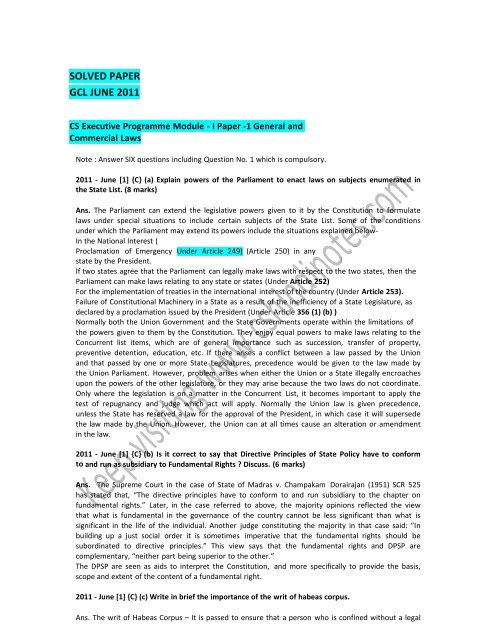
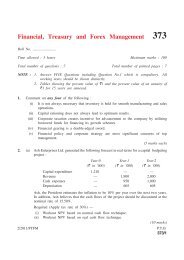

![vf/kfu;e dk vFkZ 'fu.kZ;' [ Interpretation of Statues ] Statue ... - cs notes](https://img.yumpu.com/38855798/1/190x245/vf-kfue-dk-vfkz-fukz-interpretation-of-statues-statue-cs-notes.jpg?quality=85)
